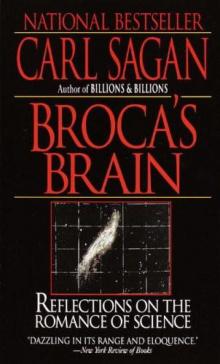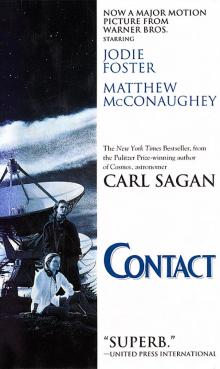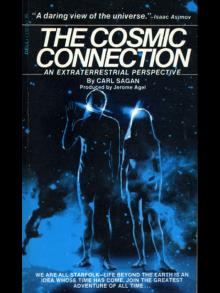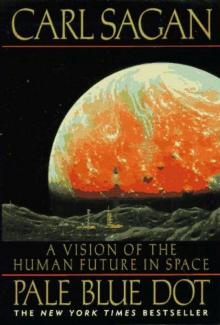- Home
- Carl Sagan
Comet, Revised
Comet, Revised Read online
UNPRECEDENTED ACCLAIM FOR COMET
“Easy to read … a delightful sense of humor … Beguiling.”
—ASSOCIATED PRESS
“A glory.”
—THE BOSTON GLOBE
“The Cadillac of comet books.”
—AMERICAN LIBRARIES
“Better than Disney World and Cape Kennedy wrapped into one … You will be entranced.”
—TAMPA TRIBUNE
“The book to hand down for great-grandchildren to read.”
—HARTFORD COURANT
“Mixes solid scientific knowledge with a healthy dose of fun … Comet is a welcome breath of fresh air.”
—HAMILTON SPECTATOR (ONTARIO)
SOME OTHER BOOKS BY THE AUTHORS:
Cosmos (C.S.)
Contact (C.S.)
Murmurs of Earth: The Voyager Interstellar Record
(C.S. A.D. et al.)
A Famous Broken Heart (A.D.)
Broca’s Brain (C.S.)
The Dragons of Eden (C.S.)
A Path Where No Man Thought: Nuclear Winter and the End of the Arms Race (C.S. and Richard Turco)
Shadows of Forgotten Ancestors: A Search for Who We Are
(C.S., A.D.)
Pale Blue Dot: A Vision of the Human Future in Space (C.S.)
The Demon-Haunted World: Science as a Candle in the Dark (C.S.)
Billions and Billions: Thoughts on Life and Death at the Brink of the Millennium (C.S.)
Copyright © 1997 by Ann Druyan and the Estate of Carl Sagan
Copyright © 1985 by Carl Sagan and Ann Druyan
All rights reserved under International and Pan-American Copyright Conventions. Published in the United States by Ballantine Books, a division of Random House, Inc., New York, and simultaneously in Canada by Random House of Canada Limited, Toronto. Originally published in slightly different form by Random House, Inc., in 1985.
http://www.randomhouse.com
Library of Congress Catalog Card Number: 96-95203
eISBN: 978-0-307-80105-0
v3.1
To Shirley Arden,
for more than a decade of friendship
and hard work well done.
With our love and admiration.
Contents
Cover
Other Books by This Author
Title Page
Copyright
Dedication
Introduction
Part I: The Nature of Comets
1 — Astride the Comet
2 — Portent
3 — Halley
4 — The Time of the Return
5 — Rogue Comets
6 — Ice
7 — The Anatomy of Comets: A Summary So Far
8 — Poison Gas and Organic Matter
9 — Tails
10 — A Cometary Bestiary
Part II: Origins and Fates of the Comets
11 — At the Heart of a Trillion Worlds
12 — Mementos of Creation
13 — The Ghosts of Comets Past
14 — Scattered Fires and Shattered Worlds
15 — The Wrath of Heaven: 1. The Great Dying
16 — The Wrath of Heaven: 2. A Modern Myth?
17 — The Enchanted Region
Part III: Comets and the Future
18 — A Flotilla Rising
19 — Stars of the Great Captains
20 — A Mote of Dust
Appendices
Bibliography
About the Authors
Introduction
Before the Earth was formed, there were comets here. Afterwards, and for all subsequent eons, comets have graced our skies. But until very recently, the comets performed without an audience; there was, as yet, no consciousness to wonder at their beauty. This all changed a few million years ago, but it was not until the last ten millennia or so that we began to make permanent records of our thoughts and feelings. Ever since, comets have left a good deal more than dust and gas in their wakes; they have trailed images, poetry, questions, and insights. In this book, we have sought to rediscover those trails, to explore our present understanding of the comets, and to speculate on what else may be possible.
We were inspired by the 1985/86 return of one of the Earth’s most brilliant (and punctual) visitors, Halley’s Comet, and the promising 1997 apparition of a previously unknown comet, Hale-Bopp.
We have tried to give some sense of the evolution of scientific discovery, and present the evidence for and against those cometary theories that have been rejected, those that are currently fashionable, and some that are neither fashionable nor rejected. We hope we have indicated clearly which is which. Certain concepts and terms are presented more than once for clarity and accessibility to the general reader. This is not by any means a mathematical book, but all modern science is quantitative and so we have included a little arithmetic here and there. When we want to know how far away something is, we could measure in miles or versts or leagues. Nature is just the same no matter what measuring rods we use. But because it is the scientific convention, because the vast majority of nations on the planet have adopted it, and because it is simpler, we will here employ the metric system. A meter is about a yard long. A thousand of them make a kilometer, which is about 60 percent of a mile. If we imagine a meter divided into a hundred equal parts, each part is a centimeter. A little over two and a half centimeters make an inch. A micron is a millionth of a meter, much too small to see. Ten thousand atoms, shoulder to shoulder, make a chain one micron long. Your fingernail is about ten thousand microns wide, or around one centimeter.
For reasons of length and readability, we have included the names of only a tiny fraction of the cometary scientists alive today. They have transformed the subject into one of the most exciting areas of modern science. Far more of them exist than the total number of cometary scientists who have lived in all previous generations. We beg the indulgence of those whose names we have omitted. The interested reader can follow the trail of original scientific papers to find the names of these specialists through the bibliography in the back of the book. In that bibliography, we have included both popular books on astronomy and representative or especially interesting works from the scientific literature.
We are indebted to the world astronomical community for their generosity to us throughout the preparation of this book. Joseph Veverka of Cornell University, a moving force behind U.S. plans for spacecraft missions to the asteroids and the comets, served as chief technical consultant and reviewer, and provided many astronomical images for the book. We are grateful to Andrea Barnett, Mary Roth, John Kaprielian, and Margaret Dermott for facilitating our acquisition of these photographs. Mark Washburn fulfilled several research assignments with his customary diligence and excellence.
Several colleagues were kind enough to read earlier drafts of this book and provide detailed and valuable comments: Luis W. Alvarez, Martha Hanner, Joseph Marcus, Steven Soter, Paul Weissman, and Donald K. Yeomans, who also calculated the dates of the future returns of Halley’s Comet. Others who permitted us to tap their expertise include John C. Brandt, Donald Brownlee, Stephen Jay Gould, Brian Marsden, Richard Muller, Marcia Neugebauer, Ray Newburn, Sara Schechner Genuth, Zdenek Sekanina, J. John Sepkowski, Jr., Eugene M. Shoemaker, Reid Thompson, and Fred L. Whipple. We are deeply grateful to all of them.
One of the most pleasant experiences in writing this book was our encounter with Ruth S. Freitag, Senior Science Specialist of the Science and Technology Division of the Library of Congress. Her knowledge, enthusiasm for her subject, and willingness to share a treasury of comet illustrations speaks well of the nation’s library.
The visual content of Comet is largely due to Jon Lomberg, an artist whose dreams are informed by science. His diagra
ms—produced with Simon Bell and Jason LeBel of Bell Production Services, Toronto, Canada—teach painlessly and with elegance. In addition to reviewing the manuscript, Jon also coordinated the efforts of other artists in producing specially commissioned paintings for this book. We are proud to display herein the work of some of the planet’s finest astronomical artists:
Michael Carroll Pamela Lee
Don Davis Jon Lomberg
Don Dixon Anne Norcia
William K. Hartmann Kim Poor
Kazuaki Iwasaki Rick Sternbach
Our chapter on the life of Edmond Halley is illustrated with a number of images that have come to us through the kindness of Michael Thomas of A.M. Heath, London. We also thank Maren Leyla Cooke and Takako Suzuki for prehistoric animals and ancient calligraphy, respectively, and Donald K. Yeomans for giving us access to his personal collection of cometary pictures.
The manuscript was expertly guided through its many incarnations by Shirley Arden, whom we acknowledge in the dedication, and then by William Barnett. The illustrations in this revised edition have again benefited from the unique skills of Jon Lomberg. We also thank Pandora Peabody and Maruja Farge, who in different ways made fundamental contributions to this book.
Patricia Parker, professor of comparative literature, University of Toronto, introduced us to the possibilities of a concordance of the world’s cometary literature, launching us on a heady voyage. We have benefited from the remarkable breadth and depth of the scholarly community at Cornell University. Patricia Gill of the Department of English provided us with original translations of numerous ancient comet references and literary allusions and assembled a corps of talented researchers and translators, including Ann Bishop, Milad Doueihi, Michael D. Layne, Jim LeBlanc, Gina Psaki, Heather Smith, Karen Swenson, and Xie Yong.
We thank Howard Kaminsky, Jason Epstein, Robert Aulicino, Nancy Inglis, and Ellen Vanook at Random House and Linda Grey at Ballantine for their efficient production; Derek Johns for helpful line-editing and many courtesies; Scott Meredith, Jack Scovil, Jonathan Silverman, Bill Haas, and others at the Scott Meredith Literary Agency for services that went beyond the usual norms in making Comet possible; and Cynthia Cannell and Mort Janklow of Janklow & Nesbit Associates literary agency. Our thanks to Dorion Sagan for his support. We are also grateful to Kel Arden, David Aylward, Daniel Boorstin, Frank Bristow, Brian Dias, George Finlay, Andrew Fraknoi, Louis Friedman, A. L. Gabriel, Irving Gruber, Annie Guehenno, Jean-Marie Guehenno, Theodore Hesburgh, P. D. Hingley, Michel-Henri Lepaute, Bob Marcoux, Jerred Metz, Nancy Palmer, David Pepper, N. W. Pirie, George Porter, Roald Sagdeev, Alan Stahl, Andy Su, Peter Waller, Jean Wilson, Eleanor York, and Robert Zend.
The thirtieth recorded apparition of Halley’s Comet and the appearance of Hale-Bopp, a comet never before seen in recorded human history, bring us face to face with the great question of our time. They arrive just as we have become a spacefaring civilization, and just as we have devised the means to destroy ourselves. We recall those eons during which there were no beings on Earth to marvel at the comets; we hope, at least until the Sun dies, that will never be the case again.
You lift your children onto your shoulders that they may better see a comet and, in so doing, join a chain of generations that stretches back far beyond the reach of written memory. There is no cause more important than protecting that ancient and most precious continuity.
—CARL SAGAN AND ANN DRUYAN
ITHACA, NEW YORK
AUGUST 6, 1985 AND
NOVEMBER 7, 1996
PART I
The Nature of Comets
CHAPTER 1
Astride the Comet
How vast is creation! I see the planets rise and the stars hurry by, carried along with their light! What, then, is this hand which propels them? The sky broadens the more I ascend. Worlds revolve around me. And I am the center of this restless creation.
Oh, how great is my spirit! I feel superior to that miserable world lost in the immeasurable distance beneath me; planets frolic about me—comets pass by casting forth their fiery tails, and centuries hence they will return, still running like horses on the field of space. How I am soothed by this immensity! Yes, this is indeed made for me; the infinite surrounds me on all sides. I am devouring it with ease.
—GUSTAVE FLAUBERT, SMARH, 1839, TRANSLATED BY JIM LEBLANC
These are the snows of yesteryear, the pristine remnants of the origin of the solar system, waiting frozen in the interstellar dark. Out here trillions of orbiting snowbanks and icebergs are stored, gently suspended about the Sun. They cruise no faster than a small propeller-driven aircraft would, buzzing through the blue skies of far-off Earth. The slowness of their motion just balances the gravity of the distant Sun, and, poised between feeble contending forces, they take millions of years to complete one orbit around that yellow point of light. Out here you are a third of the way to the nearest star. Or rather, to the next nearest star: In the depth and utter blackness of the dark sky around you, it is entirely clear that the Sun is one of the stars. It is not even the brightest star in the sky. Sirius is brighter, and Canopus. If there are planets circling the star called the Sun, there is no hint of them from this remote vantage point.
These trillions of floating icebergs fill an immense volume of space; the nearest one is three billion kilometers away from you, about the distance of the Earth from Uranus. There are many icebergs, but the space they fill, a thick shell surrounding the Sun, is incomprehensibly vast. Most of them have been out here since the solar system began, quarantined from whatever mischief may be going on down there, in that alien and hostile region bordering the Sun.
Beyond the occasional soft ping of a cosmic ray from some collapsed star at the other end of the Milky Way, hardly anything ever happens here. It is very peaceful. But something has happened, a gravitational intrusion, not by the Sun or its possible planets, but by another star. It was slow in coming, and at its closest it was never very near. You can see it over there, glowing faintly red, much dimmer than the Sun. This cloud of icebergs has been carried with the Sun on its motions through the Milky Way Galaxy. But other stars have their own characteristic motions, and sometimes by accident approach us. So on occasion, as now, there is a little gravitational rumbling, and the cloud trembles.
Since your iceberg is bound so weakly to the Sun, even a little push or tug is enough to throw it onto some new trajectory. The neighboring icebergs—much too small and distant for you to see directly—have been similarly affected, and are now hurrying off in many directions. Some have been shaken loose from the gravitational shackles that had bound them to the Sun, and are now liberated from their ancient servitude, embarking on odysseys into the vast spaces between the stars. But for your iceberg there is a different destiny working itself out: You have been tugged in such a way that you are now falling, slowly at first, but with gradually increasing speed—down, down, down toward the point of light about which this vast collection of little worlds slowly revolves.
Imagine that you are as patient and long-lived as the iceberg on which you are standing, that you have adequate life expectancy and life-support equipment for a journey of thousands to millions of years. You are falling toward the bright yellow star. Your worldlet and its brethren have been given a name. Comets, they are called. Your comet—perhaps it is one called Hale-Bopp—is an emissary from the kingdom of ice to the infernal realm near the Sun.
Out here a comet is only an iceberg. Later on, the iceberg will be just one part of the comet, called the nucleus. A typical cometary nucleus is a few kilometers across. Its surface area is the size of a small city. If you were standing on it you would see the smoothly curving contours of gracefully sculpted hillocks built of very dark, reddish-brown ice. There is no air on this small world, nothing liquid, and—apart from you yourself—nothing alive, at least so far as you can see. You can, over the following millions of years, explore every corner, every mountain, every crevice. With the skies perfectly clear, and with no par
ticularly urgent tasks before you, you can also spend a little time studying the magnificent array of unwinking bright stars that surrounds you.
The scale of the solar system.
The inner solar system, with the Sun in the center and, shown as four concentric circles, the orbits of the terrestrial planets, Mercury, Venus, Earth, and Mars. Beyond the orbit of Mars is a cloud of small asteroids, shown here as dots. Also displayed is the elliptical orbit of Comet Encke. The Earth’s distance from the Sun—150 million kilometers or 93 million miles—is called 1 Astronomical Unit (A.U.) and is shown in the scale.
The boundaries of the planetary part of the solar system, as known today. The boundary of the previous figure is embedded in this diagram as the small square in the center. Shown are the concentric orbits of the jovian planets, Jupiter, Saturn, Uranus, Neptune, as well as the smaller planet Pluto—most of the time the outermost planet, but in the late twentieth century slightly closer to the Sun than Neptune. The highly elliptical orbit is that of Halley’s Comet, which at aphelion takes it beyond the orbit of Neptune. The scale of this diagram is 100 Astronomical Units.
The inner edges of the Oort Cloud. The planetary part of the solar system is contained in the small square at center, and the highly eccentric orbit of a long-period comet is shown. The orbit of Hale-Bopp is somewhat similar. The dots represent the inner edge of the cloud of comets, which perhaps begins less than 100 A.U. from the Sun.
The solar system on its grandest scale. The previous three figures are subsumed in a dot too small to see at the center of this picture, where the Sun and the planets are located. Surrounding the Sun out to a distance of 100,000 Astronomical Units is a great spherical assemblage of comets called the Oort Cloud. It reaches halfway to the nearest stars. Diagrams by Jon Lomberg/BPS.

 Cosmos
Cosmos Murmurs of Earth
Murmurs of Earth Broca's Brain
Broca's Brain Comet
Comet Contact
Contact Dragons of Eden
Dragons of Eden Cosmic Connection
Cosmic Connection Shadows of Forgotten Ancestors
Shadows of Forgotten Ancestors Billions & Billions
Billions & Billions Comet, Revised
Comet, Revised Broca's Brain: The Romance of Science
Broca's Brain: The Romance of Science The Varieties of Scientific Experience: A Personal View of the Search for God
The Varieties of Scientific Experience: A Personal View of the Search for God The Cosmic Connection
The Cosmic Connection Pale Blue Dot: A Vision of the Human Future in Space
Pale Blue Dot: A Vision of the Human Future in Space The Dragons of Eden
The Dragons of Eden